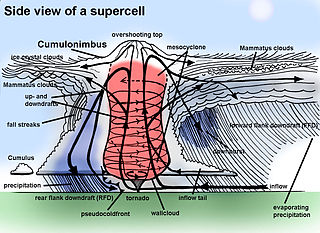
A mesocyclone is a meso-gamma mesoscale region of rotation (vortex), typically around 2 to 6 mi in diameter, most often noticed on radar within thunderstorms. In the northern hemisphere it is usually located in the right rear flank of a supercell, or often on the eastern, or leading, flank of a high-precipitation variety of supercell. The area overlaid by a mesocyclone’s circulation may be several miles (km) wide, but substantially larger than any tornado that may develop within it, and it is within mesocyclones that intense tornadoes form.

A severe thunderstorm watch is a statement issued by weather forecasting agencies to advise the public that atmospheric conditions in a given region may lead to the development of severe thunderstorms within the region over several hours. The criteria for issuing a watch varies from country to country and may also include torrential rainfall and tornadoes. A watch may also be issued several hours ahead of the arrival of a mature and organized complex of storms, such as a mesoscale convective system.
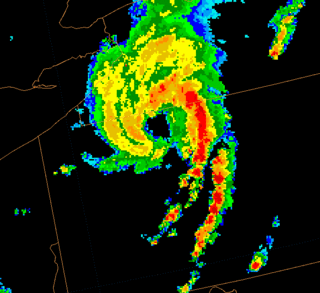
A squall line, or more accurately a quasi-linear convective system (QLCS), is a line of thunderstorms, often forming along or ahead of a cold front. In the early 20th century, the term was used as a synonym for cold front. Linear thunderstorm structures often contain heavy precipitation, hail, frequent lightning, strong straight-line winds, and occasionally tornadoes or waterspouts. Particularly strong straight-line winds can occur where the linear structure forms into the shape of a bow echo. Tornadoes can occur along waves within a line echo wave pattern (LEWP), where mesoscale low-pressure areas are present. Some bow echoes can grow to become derechos as they move swiftly across a large area. On the back edge of the rainband associated with mature squall lines, a wake low can be present, on very rare occasions associated with a heat burst.

The Storm Prediction Center (SPC) is a US government agency that is part of the National Centers for Environmental Prediction (NCEP), operating under the control of the National Weather Service (NWS), which in turn is part of the National Oceanic and Atmospheric Administration (NOAA) of the United States Department of Commerce (DoC).

A derecho is a widespread, long-lived, straight-line wind storm that is associated with a fast-moving group of severe thunderstorms known as a mesoscale convective system.

The New York State Labor Day Derechos were two derecho events that occurred on Labor Day, September 7, 1998. One derecho moved through northern and central New York state, and the other would start in southeastern Michigan and move through northeastern Ohio, Pennsylvania, New Jersey, and Long Island. A spokesman for the New York State Emergency Management Office, estimated that 300,000 residences had lost electricity, 7 persons died and 80 were injured.
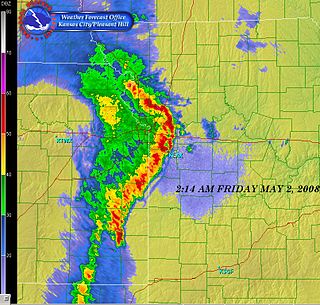
A bow echo is the characteristic radar return from a mesoscale convective system that is shaped like an archer's bow. These systems can produce severe straight-line winds and occasionally tornadoes, causing major damage. They can also become derechos or form Line echo wave pattern (LEWP).
The heat wave of 2006 derecho series were a set of derechos — severe winds with powerful thunderstorms — that occurred on July 17–21, 2006. The first storms hit a wide swath of north-central and northeastern North America that stretched from the Upper Midwest through much of Ontario and into the northeastern United States. Another round struck the middle Mississippi River Valley, including two derechos that hit St. Louis, Missouri. The storms left more than three million people without power, some more than once and some for weeks.
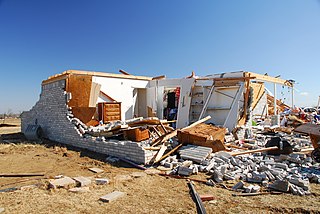
On February 10–11, 2009, a broad-scale damaging wind event and small tornado outbreak affected the Central and Eastern United States. During the two-day period, 14 tornadoes touched down in seven states. Oklahoma was struck by six tornadoes, the most of any state. The six tornadoes in Oklahoma also tied the record for the most tornadoes ever recorded in the state during the month of February, which would later be broken in 2023. The first day of the outbreak produced the most tornadoes; the second brought mainly high wind damage and rain or snow in most of the Northeast.
A mesovortex is a small-scale rotational feature found in a convective storm, such as a quasi-linear convective system, a supercell, or the eyewall of a tropical cyclone. Mesovortices range in diameter from tens of miles to a mile or less and can be immensely intense.

The 2010 Bronx tornado was a rare EF1 tornado which struck the Bronx in New York City, United States, touching down there on July 25, 2010 and traveled 1 mi (1.6 km). The tornado, which was the second ever tornado recorded in the Bronx, touched down around 2:55 p.m. EDT in Riverdale, located within the Bronx, causing damage to buildings, trees, cars, and power lines. Seven people were injured along its track due to broken glass. The tornado lifted around 3:00 p.m. EDT while still within the Riverdale neighborhood.
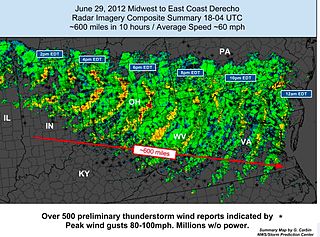
The June 2012 Mid-Atlantic and Midwest derecho was one of the deadliest and most destructive fast-moving severe thunderstorm complexes in North American history. The progressive derecho tracked across a large section of the Midwestern United States and across the central Appalachians into the mid-Atlantic states on the afternoon and evening of June 29, 2012, and into the early morning of June 30, 2012. It resulted in a total of 22 deaths, millions of power outages across the entire affected region, and a damage total of US$2.9 billion which exceeded that of all other derecho events aside from the August 2020 Midwest derecho. The storm prompted the issuance of four separate severe thunderstorm watches by the Storm Prediction Center. A second storm in the late afternoon caused another watch to be issued across Iowa and Illinois.

From June 12 to June 13, 2013, two derechos occurred across different areas of the Eastern United States. The initial derecho formed on the afternoon of June 12 and tracked across a large section of the Midwestern United States, the central Appalachians, and the Mid-Atlantic states before moving into the Atlantic Ocean during the morning of June 13. A second, more widespread and intense derecho occurred on June 13 across the Southeastern United States, resulting in major wind damage across North Carolina, Virginia, and Maryland, among other states. These storms caused at least three deaths and extensive damage property damage – resulting from both tornadoes and straight-line winds – from Iowa to South Carolina. 28 tornadoes touched down in Iowa, Illinois, Ohio, Georgia, North Carolina, Maryland, Virginia, and Tennessee. One of the tornadoes in Iowa was rated as a high-end EF3, destroying a restaurant and two houses. One person was injured by another tornado, rated EF2, in Carroll County, Illinois, and nine people were injured by an EF1 in Cherokee County, Georgia.

The August 2020 Midwest derecho was a powerful derecho affecting the Midwestern United States on August 10–11, 2020, primarily eastern Nebraska, Iowa, Illinois, Wisconsin, and Indiana. It caused high winds and spawned an outbreak of weak tornadoes. Some areas reported torrential rain and large hail.
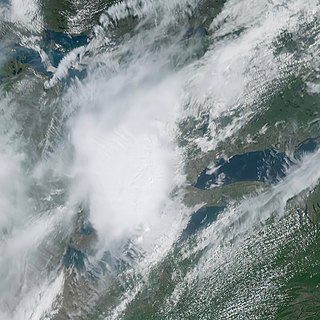
The May 2022 Canadian derecho was a high-impact derecho event that affected the Quebec City-Windsor Corridor, Canada's most densely populated region, on May 21, 2022. Described by meteorologists as a historic derecho and one of the most impactful thunderstorms in Canadian history, winds up to 190 km/h (120 mph) as well as around four tornadoes caused widespread and extensive damage along a path that extended for 1,000 kilometres (620 mi).
The June 2020 Rocky Mountains-Northern Plains derecho was a rare derecho that moved across at least 750 miles and affected eight US states on June 6, 2020. The derecho was notable for forming in a highly unusual location west of the Rocky Mountains and crossing the Continental Divide. The storm which crossed the entire state of Colorado was the first storm to impact the state on record and only the third reported in the Western United States.















